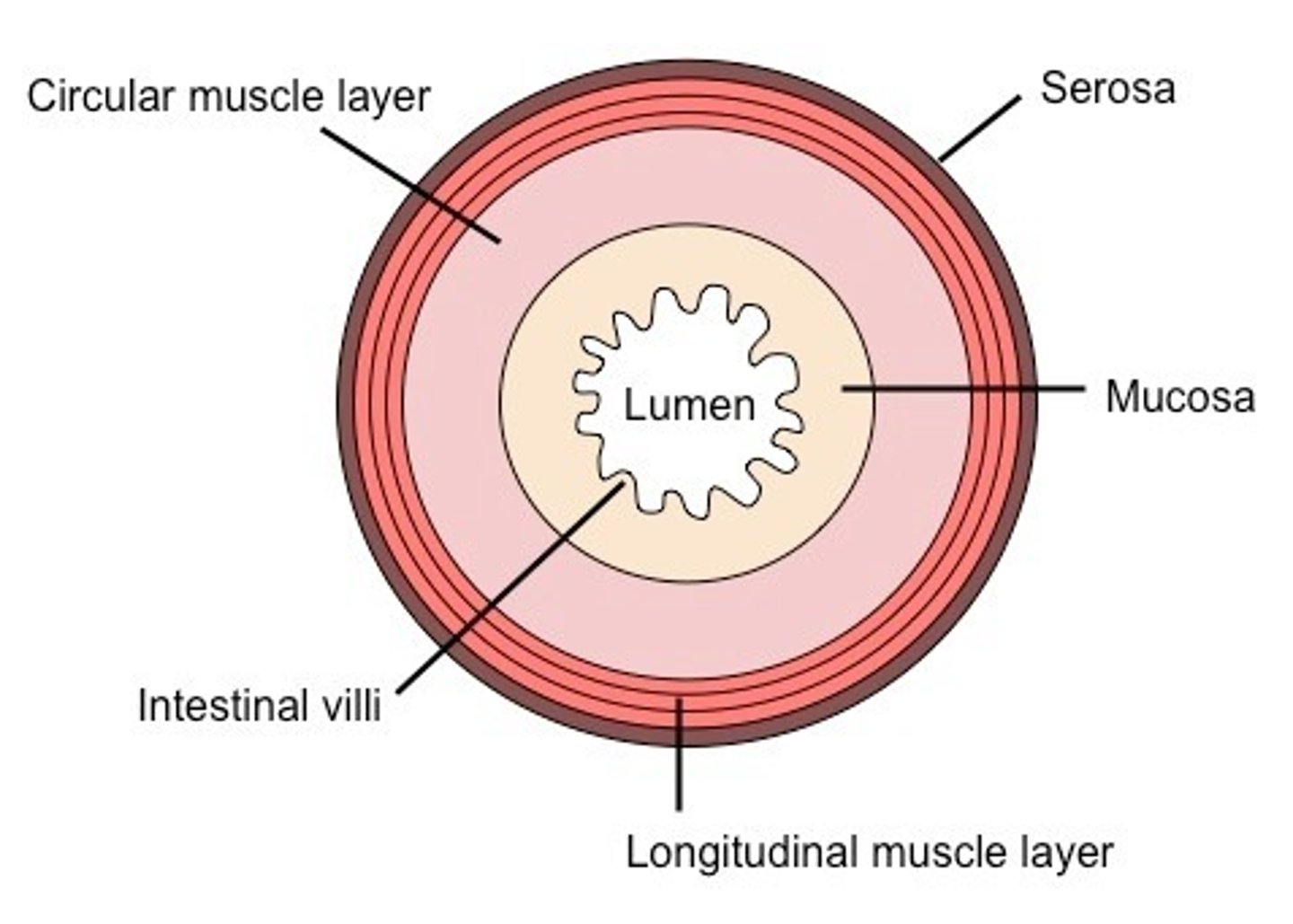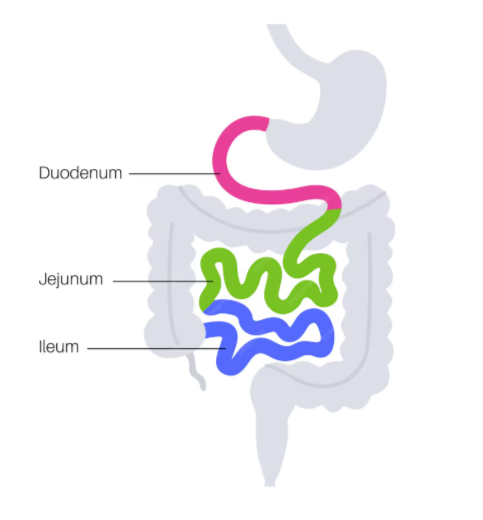GI Physiology of the GIT
1/39
There's no tags or description
Looks like no tags are added yet.
Name | Mastery | Learn | Test | Matching | Spaced |
|---|
No study sessions yet.
40 Terms
Functions of the GIT
Digestion, transport of water, nutrients, and electrolytes, and defensive barrier
Digestive Process
Ingestion, motility (driving food along intestinal tract), mechanical breakdown (chewing etc.), chemical breakdown (enzymatic degradation), absorption/secretion and defecation
Intestine Structure
Lumen, mucosa, submucosa, circular muscle, longitudinal muscle, serosa

Mucosa
Innermost layer of the GIT, surrounding the lumen. It's made up of epithelium (innermost layer), lamina propria and muscularis mucosa
Submucosa
Connective tissue containing blood and lymphatic vessels, nerve fibers and lymphoid follicles
Muscularis (consists of circular and longitudinal muscle) function
Consists of smooth muscle cells which are responsible for controlling intestinal motility (segmentation + peristalsis)
Serosa
Consists of rough, connective tissue
4 types of epithelial cells in the intestine
1. Enterocytes
2. Goblet cells
3. Paneth cells
4. Enteroendocrine cells
Enterocytes function
Transport fluid, nutrients, and electrolytes. Also secrete beta-defensin in the colon.
Goblet cells function
Secrete mucus, protecting mucosa from abrasion
Paneth cells function
Secrete antimicrobial peptides (alpha-defensins) which kill pathogenic bacteria
Enteroendocrine cells function
Luminal sensors, secrete mediators, peptides, and hormones
Epithelium
Part of mucosa. Innermost layer of intestine which lines the lumen. It's characterised by tight junctions.
Epithelium structures
1. Stratified squamous
2. Simple columnar
stratified squamous epithelium function
- Protects against wear & tear, and secretes fluid and mucus
- Found in mouth, oesophagus, and anal canal
- No nutrient transporters
simple columnar epithelium function
- Absorption and secretion
- Found throughout rest of intestine
- Express proteins involved in fluid, nutrient, and electrolyte transport.
The epithelium poses a...
...physical phospholipid barrier in which only lipophilic molecules can directly diffuse across
Epithelium tight junctions function
Only allow small ions/molecules to pass through and prevent bacteria and toxin entry
Enteric Tear Mechanism
When toxins/pathogens are present in the lumen, the lower intestine can switch from being absorptive to secretory (e.g. diarrhoea)
Most prevalent epithelial cells in small intestine
Enterocytes
Where are immune cells found in the intestine?
In the lamina propria (part of the mucosa)
What do immune cells do?
Engulf and kill bacteria, and release cytokine which is responsible for lymphocyte-mediated-immunity
Where are smooth muscle cells found in the intestine?
In the muscularis layer (circular & longitudinal)
Segmentation (circular muscle)
Mixes and churns food bolus
Peristalsis (longitudinal muscle)
Propels food along GIT
What the enteric nervous system (ENS) is made up of and their functions?
200M neurons and:
1. submucosal plexus which regulates epithelial function
2. myenteric plexus which regulates smooth muscle contraction
Sensory neurons' role in GIT
Receive info from mucosa and activates muscle to stretch
Motor neurons' role in GIT
Control muscular contractions and epithelial secretion + absorption
Inter-neurons' role in GIT
Integrate information
What are enteroendocrine cells?
Epithelial cell type specialised for sensing changes in intestinal environment e.g. pH. They release mediators, peptides, and hormones
Types of enteroendocrine cells
G, S, I, L cells
G cells location and function
Stomach epithelium. Release gastrin in response to nutrients
S cells location and function
Duodenum epithelium. Release secretin in response to luminal HCl
I cells location and function
Duodenum/jejunum epithelium. Release cholecystokinin in response to nutrient and caloric intake
L cells location and function
Ileum/colon epithelium. Release GLP-1

Parts of small intestine
Duodenum (1st part)
Jejunum (2nd part)
Ileum (3rd part)
Where are enterocytes found?
Small intestine epithelium (most prevalent epithelial cell here!)
Where are Goblet cells found?
Small and large intestine epithelium
Where are Paneth cells found?
Small intestine epithelium
Where are enteroendocrine cells found?
All along GIT epithelium e.g. G, S, I, L cells found in various locations.